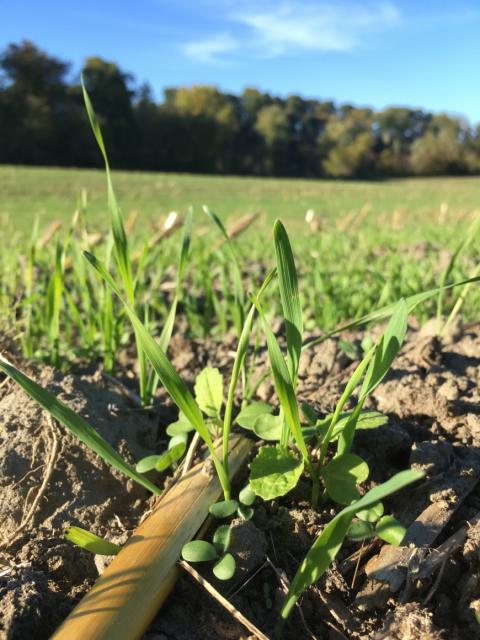Cover Crops in NH –Looking Back, Looking Forward

It wasn’t all that long ago that the acres of bare soil going into the winter far outnumbered the acres with some kind of cover crop. You’d look across the landscape a month after everyone was done chopping corn, and you’d mostly see brown, not green.
Farmers are very much aware of just how much their livelihoods depend on their soil, and they have increasingly taken steps to improve it. According to USDA’s Census of Agriculture, acres in cover crops increased from 5,025 in 2012 to 8,326 in 2017 – an increase of 66%. While we don’t yet have official numbers, it’s likely that the total acreage has increased further in the past couple years.
In roughly that same time span, there’s been considerable research in the Northeast to fine-tune recommendations for maximizing the benefits cover crops can provide. Extension has worked with NRCS, Conservation Districts, and other ag service providers to develop NH-specific cover crop mixes that provide a variety of benefits to growers of both field crops and vegetable crops, and that can thrive in the state’s climate. We’ve also worked to evaluate their performance, along with dozens of cooperating farms across the state who have sown them in their fields. Other farms are conducting their own experiments with different species to determine which ones are a good fit for their land, and they’ve experimented with harvesting the lush spring growth as a way to add more high-quality forage to their feed inventory. With all this work, we’ve learned some important lessons.
Timing is everything. Most of the benefits from cover crops depend on accumulating plenty of biomass that protects the soil surface and feed soil microorganisms, and that takes some time. Research around the Northeast indicates that you should be OK as long as you can get your seed in the ground by mid-September. However, the chances of a successful stand start to drop steeply once you get into October. We’ve found that early-planted cover crops yield as much as 3 tons of biomass per acre, but the same mix planted even just a couple weeks later yield about third of that.
Some components of a mix are going to fare better than others. With small grains, rye seems to withstand whatever conditions winter throws at it, while wheat and barley are more sensitive to winter injury. Among legumes, hairy vetch seems to be more winterhardy around here than crimson clover, which did quite well during the mild winter we had a couple years ago, but not so much in the colder, closer-to-normal conditions we experienced this past winter. As for ‘tillage’ radishes, the only way you’re going to get the impressive, compaction-busting taproots one sees in seed catalogs is with an early planting date – as early as late August. This works well in certain vegetable crops, but it’s not going to work for silage corn, where a more likely mid-September planting date will yield taproots the size of baby carrots. When you want to have your cover crops pull double duty as winter forage, timing and seed placement become even more important; seed drilled by mid-September will give impressive yields, while seed broadcast at the tail end of the month or later will hardly make it worth your while to harvest in spring.
It’s often tricky to plan around this. Many farms order their seed corn right about now, and they order their cover crop seed in mid-summer, but there’s no way of knowing what the upcoming growing season or subsequent fall is going to be like. A stretch of weather that’s hotter, cooler, drier, or wetter than normal – and there’s a good chance it’s going to be one of those - can have big impacts on how the crop develops and when it’s ready to harvest. That, in turn, dictates when you can get out there with the seed drill, and then fall conditions dictate how well the seed you sowed is going to do. It’s a challenge, but making frequent and careful observations and keeping good records can help you make plans that maximize the benefits while minimizing the risk.
And remember that despite the challenges, farmers are seeing plenty of benefits from cover crops on their land. Sometimes these show up in subtle ways; small but noticeable reductions in soil loss from wind or rain erosion, or the ability to get on the fields a little earlier in spring because that carpet of green plants is pulling a surprising amount of moisture out of the soil. Some benefits, like conserving nitrogen or building up soil organic matter, show up gradually over several years. Still, farms intuitively know that using cover crops pays dividends; “It just looks a lot better when the fields are green going into winter than when they’re brown”, a farmer once noted as we looked out at the fields he sowed to rye and triticale some weeks previously. We couldn’t agree more.

